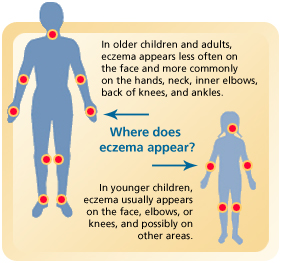Diagnosing Eczema
Recognizing Eczema
Atopic dermatitis (eczema) is a common, recurring skin condition characterized by a dry, flaky, itchy rash. Eczema can appear on different parts of the body depending on your age. Its appearance may also vary depending on its severity and location on the body.
Following are pictures of four of the most common features of the rash of eczema:
Patchy Skin (Erythema) - skin redness

| MILD faintly detectable erythema; very light pink |
MODERATE dull red; clearly distinguishable |
SEVERE deep/dark red |
Bumpy Skin (Papulation) - appearance of bumps

| MILD barely perceptible elevated papules |
MODERATE clearly perceptible papules but not extensive |
SEVERE marked and extensive discrete papules |
Red Open Sores (Excoriation) - lesions caused by scratching

| MILD scant evidence of excoriations with no signs of deeper skin damage (erosion, crust) |
MODERATE several linear marks of skin with showing evidence of deeper skin injury (erosion, crust) |
SEVERE many erosive or crusty lesions |
Scaly Skin (Lichenification) - lines in skin caused by chronic inflammation

| MILD slight thickening of the skin discernible only by touch and with skin markings minimally exaggerated |
MODERATE definite thickening of the skin; skin markings exaggerated so that they form a visible criss-cross pattern |
SEVERE thickened or indurated skin with skin markings visibly portraying an exaggerated criss-cross pattern |
Eczema may include one or a combination of the symptoms mentioned above. Here are some examples of people with an eczema flare-up.

If the affected skin becomes very inflamed, open sores, called ulcers (UHL-sirs), may occur. A clear, sticky fluid may even weep from the affected skin. This can make it hard for the healthcare provider to decide if the skin is affected by eczema or by a skin infection. In fact, both can occur at the same time. When the skin has been affected for a long time, it can become thick and leathery. The good news is that the rash can be controlled.

In children and adults, eczema appears less often on the face and more commonly on the hands, neck, inner elbows, backs of the knees, and ankles. In younger children, eczema usually appears on the face, elbows, knees, and possibly on other areas.
Important Note:
Only your doctor can diagnose eczema. The features described above can appear in many types of skin rashes. Diagnosis is based on a combination of the patient’s recent medical history and family history, in addition to a physical examination.
Revision date: June 11, 2011
Last revised: by Sebastian Scheller, MD, ScD